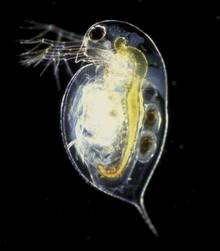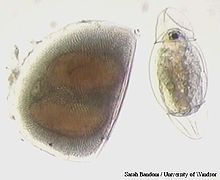Daphnia
| Daphnia | ||||||||||||
|---|---|---|---|---|---|---|---|---|---|---|---|---|

Representative of the genus Daphnia , |
||||||||||||
| Systematics | ||||||||||||
|
||||||||||||
| Scientific name | ||||||||||||
| Daphnia | ||||||||||||
| Müller , 1785 |
Daphnia ( Daphnia ) are a genus of crustaceans (Crustacea) that are attached to the claw tails (Onychura). The animals, which are only between 1 mm and 5 mm long, are, among others, often referred to as " water fleas " and are easy to breed.
Morphological structure
The body of the Daphnia is enclosed in a two-lobed shell ( carapace ), which only leaves the head with the powerful oar antennae free. The two shell halves close at the back and form a kind of keel that ends with a spike. The shell is a duplication of the skin, which is faceted.
The large complex eye is striking on the head . It is movable by six muscles and is made up of two parts during development. Another smaller eye, the so-called nauplius eye (see also: Nauplius larva ) is much smaller and not a complex eye. Both eyes are connected to the cerebral ganglion , the "brain" of Daphnia , via optic nerves .
The second antennae are transformed into large and conspicuous rowing organs. They consist of a trunk and two branches with bristles that fan out when “rowing”. The two-branched antennae go back to the original split bone of the crustaceans. Strong muscles enter into the trunk of the two second antennae, which enable the antennae to move. The first two antennas are much smaller. They sit above the mouth opening and wear sensory hair ( aesthetic masks ) at the end . These serve as chemoreceptors. In the males, these antennae are larger and have an additional bristle that is likely to sense mechanical stimuli. Daphnia belong to the group of mandibulata and therefore have two strong mandibles (a kind of jaw). They are wedge-shaped and slightly serrated inward.
Five pairs of “legs” lie below the bowl. They too have the character of a split-foot, are soft-skinned and get their strength from the blood pressure of the animal. Such supported extremities are also called turgor extremities . They are studded with bristles on the edge and each have a small sack-shaped appendix that acts as a gill . Daphnia also breathe through the surface of their turgor extremities and through their entire body surface. The legs are not intended for locomotion, as the second antennae already take on this task. The pairs of legs number 3 and 4 are rather used for food intake. With a quick and rhythmic beat of the legs, water and the food particles it contains are “swirled” into the interior of the bowls. The bristles on the legs act as filters and catch the food. This is then transported up to the throat in a channel between the legs and from there it enters the body or the intestine.
The rear part of the animal ( abdomen or pleon ) is slightly curved. Here are the anus and a pair of inwardly curved claws.
ecology
There may be crowds at certain times of the year. Daphnia mostly reproduce unisexually ( parthenogenetically ). That is why most of the Daphnia are females. However, when the environmental conditions in their habitat change negatively (drought, cold, shorter days, lack of food, but also toxins), males are also born and fertilize the sexual eggs of the females. Under these conditions up to 30% males are found. Sexual eggs, surrounded by a shell resistant to heat, cold and drought (ephippium), also called "winter eggs" or latency eggs (permanent eggs), can survive drought for up to two years and hatch again under good environmental conditions. In the moist sediment the shelf life of the eggs is even higher: In the lake sediments of the North American Oneida Lake , permanent eggs in sediments more than 100 years old could still be awakened from dormancy . This ability gives the Daphnia the opportunity to quickly repopulate drying or "overturned" waters. The permanent eggs also serve as stages of spread.
Ecotoxicology
Daphnia live in lakes and ponds. They are sensitive to pollutants in the water and allow a statement to be made about toxins in the water about the impairment of their ability to move. The standardized test for this is called the daphnia test .
Types (selection)
- Daphnia cristata Sars, 1861
- Daphnia cucullata Sars, 1862
- Daphnia galeata Sars, 1863
- Daphnia hyalina Leydig, 1860
- Daphnia longispina O.F. Müller, 1776
- Daphnia magna Straus, 1820
- Daphnia pulex Leydig, 1860
Daphnia as a model organism in research
Some species of the genus Daphnia are used as model organisms in biological research. In the course of this use, the genome of some species ( D. pulex , D. magna ) is sequenced. It comprises 31,000 genes.
Use in the aquarium hobby
Daphnia are often used as ornamental fish food for aquarium fish . They are regularly offered as live food in pet shops. They are also available in frozen or freeze-dried options. They contain valuable fiber and often trigger the willingness to spawn when changing feed. A multiplication of water fleas is also possible in an empty aquarium. The best feed is spirulina powder .
Web links
- Daphnia Genomics Consortium ( Wayback Machine , archived March 10, 2010)
- We outsmart death: Klaus Schwenk on the eternal life of the Daphnia. Spiegel online, accessed October 13, 2016 .
Individual evidence
- ↑ NNSmirnov: The physiology of the Cladocera . Academic Press, Amsterdam 2014.
- ^ A b Dieter Ebert: Introduction to Daphnia biology . In: Ecology, Epidemiology, and Evolution of Parasitism in Daphnia . National Center for Biotechnology Information, Bethesda, MD 2005, ISBN 978-1-932811-06-3 .
- ^ Carla E. Cáceres (1998): Interspecific variation in the abundance, production, and emergence of Daphnia diapausing eggs. Ecology 79 (5): 1699-1710. doi : 10.1890 / 0012-9658 (1998) 079 [1699: IVITAP] 2.0.CO; 2
- ↑ The water flea and its record-breaking inner values. On: Wissenschaft.de from February 4, 2011.
- ↑ http://www.aquaristik.tips/daphnien-als-lebendfutter-zuechten/


